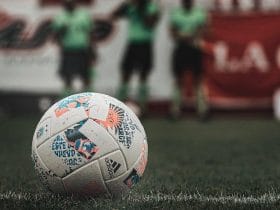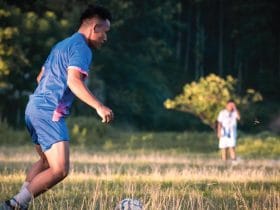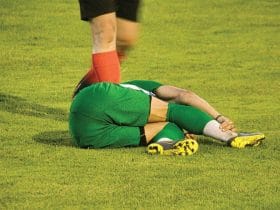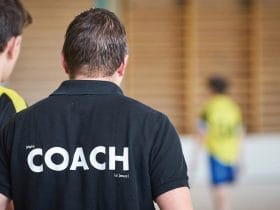Archives
Categories
Train smartly: How to avoid sports injuries
Latest Posts
OUR HOT TOPICS

To learn how to avoid sports injuries, it is essential to practice properly by following appropriate preventive measures and smart training. Every year, millions of athletes, from amateurs to professionals, suffer injuries that could have been avoided by following some guidelines during training.
If you want to enjoy any physical activity, you need to minimize the risk of injury, which ensures continuity and protects your quality of life. Sports injuries don’t just cause pain and discomfort; they can also lead to long recovery periods that disrupt training and negatively affect overall well-being.
The key to preventing sports injuries lies in a combination of proper preparation, correct techniques and adaptation to workloads. This includes everyone from novices just starting an exercise routine, to experienced athletes looking to optimize their performance without compromising their health.
We’re going to explain various strategies and techniques that can help you avoid sports injuries, whether you’re a professional or an amateur. From the importance of a proper warm-up to choosing the right equipment and proper nutrition, we offer you tips so you can train smart.
By understanding how your body works and what it needs to perform at its highest level, you can improve your favourite sport and enjoy an active life.
With the guidance of our physiotherapy clinic in Malaga, you will have a comprehensive guide to staying active and safe. And most importantly, you will have the knowledge to reduce the risk of injury while maximizing your performance.
As you progress through this article, you will know how to integrate smart training practices into your routine, regardless of your activity level. Safety in sports practice is paramount. Today, you begin a new way of training.
Learn how to avoid sports injuries with a proper warm-up
The first step in learning how to avoid sports injuries is to carry out a proper warm-up. Moreover, warming up correctly not only prevents injuries but will also help you improve your performance. This preparation process prior to the main exercise has multiple benefits that significantly contribute to the safety and effectiveness of the training.
First, warming up gradually increases body temperature and blood flow to the muscles. This increase in blood flow ensures that the muscles are well-oxygenated, which reduces the likelihood of muscle tears and other injuries. In addition, a good warm-up increases the flexibility of muscles and tendons, which means a greater range of motion and less resistance during the activity.
In psychological terms, warming up also mentally prepares the athlete for exercise. It establishes a mind-body connection that is essential for the proper technical execution of sports movements. This mental preparation helps to focus attention, reduce anxiety and set up a state of concentration vital for optimal and safe performance.
Finally, integrating a structured, sport- or activity-specific warm-up can further personalize injury protection. For example, if you participate in contact sports, you might focus on exercises that increase joint mobility and core stability. However, if you’re a runner, you might focus on dynamics to improve leg flexibility and cardiovascular endurance.
Ignoring the importance of warming up can lead to poor performance and significantly increase the risk of sports injuries. Give this aspect of training the seriousness it deserves. And remember that each sport requires a different warm-up, depending on the muscle groups you are going to work.
Learn how to avoid sports injuries: The importance of technique
Maintaining proper technique is essential to learning how to avoid sports injuries and improve performance. Each sport has its own specific movements and postures that, if performed incorrectly, can lead to short- and long-term injuries.
Proper technique is crucial because it ensures that physical stress is distributed evenly across the appropriate muscles, bones and joints. This minimises the risk of overloading specific structures. For example, in sports such as weightlifting, incorrect technique can result in excessive stress on the lower back; whereas proper technique spreads the load more evenly and safely.
Supervision by an expert is of great importance in this regard. A professional not only teaches the correct technique, but they can also correct errors in real-time, helping to avoid dangerous movements. In addition, they can provide specific exercises to strengthen the most vulnerable areas of the body in each sport. This is essential to maintain correct technique throughout the activity.
Furthermore, training in sports techniques is not just for beginners. Athletes of all levels should periodically review their technique to ensure that they do not develop bad habits that can lead to injury. This aspect is especially important when increasing the intensity or volume of training; fatigue can cause even experienced athletes to deviate from proper technique.
Finally, the use of modern technologies such as motion sensors can be an additional tool in teaching and correcting sports techniques. These resources allow for detailed visualization and understanding of sports movements, facilitating precise and personalized corrections.
Proper technique is an essential pillar in the prevention of sports injuries. Expert supervision and ongoing commitment to technical improvement are essential for anyone seeking a healthy practice.
Learn how to avoid sports injuries: Rest and recovery
On the path to how to avoid sports injuries, rest and recovery are critical components, and they are in any training regimen. These elements are critical not only to improving performance but also to preventing injuries.
After exercise, the body needs time to repair tissues and recover expended energy. Neglecting this recovery phase can significantly increase the risk of injury.
Adequate rest
Quality sleep is one of the most important aspects of rest. During sleep, the body performs most of its muscle repair and recovery processes. Lack of sleep can lead to a decrease in the production of hormones important for muscle recovery. Athletes should aim to get at least 7-9 hours of sleep each night and consider short naps after intense workouts. This will help supplement their nighttime sleep cycles.
Hydrotherapy
Another effective recovery technique is hydrotherapy, which involves using ice baths or alternating between hot and cold water. These methods help reduce inflammation and improve circulation, which can speed up the recovery process and decrease muscle soreness. Hydrotherapy is especially beneficial after high-intensity or long-duration exercise.
Active recovery periods
Active recovery, which involves doing low-intensity activities such as walking, gentle yoga, or swimming, can facilitate muscle recovery and maintain flexibility. These types of activities help maintain blood flow to the affected muscles, which promotes healing without imposing additional strain.
Nutrition
Recovery is also significantly influenced by nutrition. Consuming the right amount of protein, carbohydrates, and fat, along with hydration, is crucial to repairing muscles and replenishing energy stores. Incorporating a balanced diet that includes antioxidants and anti-inflammatory nutrients can speed up the recovery process.
Including adequate rest periods and adopting effective recovery strategies prevents injuries, ensuring that you can maintain an optimal level of training. Ignoring these aspects can lead to a vicious cycle of fatigue, decreased performance and, ultimately, injuries that could have been avoided.
How to avoid sports injuries: Nutrition and hydration
Proper nutrition and hydration are critical for any athlete looking to avoid sports injuries. These two elements are essential not only for athletic performance but also for effective recovery and injury prevention.
A well-planned nutritional strategy provides the building blocks needed to repair muscles, while proper hydration ensures that all bodily processes function efficiently.
- Proper Nutrition: Key nutrients include protein for muscle repair and growth, carbohydrates to replenish energy stores, and fats for vital functions and energy. Vitamins and minerals also play critical roles in muscle repair and injury prevention. For example, calcium and vitamin D are essential for bone health, while iron helps transport oxygen to working muscles. A diet rich in fruits and vegetables provides antioxidants that help combat oxidative stress produced by intense exercise.
- Hydration: Hydration is equally important. Dehydration can lead to decreased performance, increased fatigue, and cause muscle cramps, all risk factors for injury. Drinking enough water before, during, and after exercise ensures that the body functions properly and helps maintain lubrication in the joints.
- Timing and balance of intake: The timing of nutrient intake is also crucial. Consuming carbohydrates and protein soon after a workout can improve muscle recovery and replenish energy stores more quickly. This is especially important in high-intensity or long-duration sports.
- Supplements: In some cases, supplements may be necessary to meet the nutritional demands of athletes. However, they should always be supervised by professionals to avoid doping and ensure that the intake is safe and effective.
Use the appropriate protective equipment for each sport
Wearing the right protective equipment is a must for anyone concerned about how to avoid sports injuries. This equipment is specifically designed to protect parts of the body that are particularly vulnerable during physical activity. Choosing the right equipment and using it properly is crucial to preventing injuries and ensuring that you can enjoy your activity in the long term.
- Sport-specific protection: Depending on the sport, the type of protection required can vary considerably. For example, in contact sports such as American football, helmets, mouthguards and shoulder pads are essential to protect against compression injuries. In sports such as cycling or skating, a helmet is an essential item to protect the head in the event of a fall. In the case of running or basketball, footwear protects the joints and prevents impact injuries. Quality and fit of equipment: It is not only important to wear protective equipment, but also to ensure that it is the correct size and is properly fitted. Ill-fitting equipment is not only uncomfortable but can also increase the risk of injury rather than reduce it. It is crucial that equipment fits securely and does not restrict natural movement, allowing the athlete to perform unhindered.
- Equipment maintenance: In addition to selecting and using protective equipment correctly, it is vital to keep it in good condition. This includes cleaning it regularly, checking for signs of wear and replacing it when it no longer provides the necessary level of protection. Worn or damaged equipment may not offer the expected protection and put the athlete at unnecessary risk.
Finally, it is important that you are well informed about the benefits and correct use of protective equipment.
How to avoid sports injuries: Training intensity
The frequency, duration and intensity of your training are essential if you want to know how to avoid sports injuries. Overtraining can not only lead to reduced performance but also significantly increase your risk of injury. Putting too much strain on your muscles, joints and ligaments before they have time to fully recover is a risk you can prevent.
Careful training planning should seek a balance between workload and rest. Athletes should avoid the temptation to overtrain in the hope of rapid improvement. Instead, training should be structured so that it gradually increases in intensity and volume, allowing sufficient time for muscle and joint recovery.
There is no one-size-fits-all approach to training; what works for one athlete may not be suitable for another. Training plans should be customized based on age, fitness level, sporting experience, and any pre-existing health conditions. Consultation with physical therapy and sports training professionals can help create a regimen that minimizes injury risk while maintaining effective progress.
It is crucial for athletes to be aware of their body’s signals. Soreness, excessive fatigue, and a decrease in performance can all be indicators of overtraining. Learning to recognize these signs and adjust training frequency and intensity accordingly is vital to maintaining a healthy and sustainable training regime.
Integrating active recovery days and ensuring there is sufficient rest between intense training sessions are important practices. Activities such as yoga, gentle swimming or low-intensity cycling can contribute to muscle recovery without imposing a significant additional load.
The importance of recognizing minor injuries and treating pain
Recognizing and properly treating minor aches and pains is critical if you’re concerned about how to prevent more serious sports injuries. Ignoring early signs of injury or treating them improperly can lead to chronic problems or more serious injuries that could have been prevented with early care.
It’s important to learn to differentiate between normal workout soreness and signs of a possible injury. Muscle discomfort after a workout, known as delayed onset muscle soreness (DOMS), is common and usually not a cause for concern. However, pain that persists or intensifies, especially in joints, tendons, or ligaments, can be a sign of injury that needs evaluation.
At the first sign of injury, applying the RICE method (Rest, Ice, Compression, and Elevation) can be very effective in reducing inflammation and pain. This immediate response can help limit damage and speed up the recovery process.
If pain persists for more than a few days or affects your ability to perform everyday activities, it is important to consult a physical therapist or sports medicine physician. These professionals can provide an accurate diagnosis and develop a treatment plan that may include physical therapy, medication, or in more severe cases, specific interventions.
You should have basic knowledge of sports first aid and self-care techniques. This includes knowing how and when to use ice or heat, the correct way to apply compression bandages, and stretching and strengthening techniques.
Part of injury treatment includes prevention, which can be supported by regularly incorporating strengthening and flexibility exercises. These exercises not only help with recovery from minor injuries but can also prevent future injuries.
Flexibility and strength exercises to prevent injuries
Integrating flexibility and strength exercises is key to learning how to avoid sports injuries in your training routine.
These exercises contribute to the development of balanced muscles and strong joints, which can significantly reduce the risk of injury during intense physical activities.
- Flexibility: Stretching exercises increase the flexibility of your muscles and tendons, which improves the range of motion in your joints. Increased range of motion can help prevent injuries such as muscle tears, which occur when muscles are not flexible during strenuous activities. Regular yoga or pilates practice can be particularly effective in improving overall flexibility.
- Strengthening: Incorporating strengthening exercises, especially for the core muscles, is essential to providing stability to the body. Strong, balanced muscles around major joints, such as the knees, hips, and shoulders, better withstand the demands of different sports and activities. Exercises such as squats, lunges, and working with weights or resistance bands are effective in developing this necessary strength.
- Integrated routines: For athletes, it is vital to combine flexibility and strength in a single training session or to alternate days focused on each. This ensures balanced muscle development and prevents overtraining of certain muscle groups, a common factor in the onset of injuries.
- Personalization by sport: Depending on the sport being practised, certain muscle groups will need special attention in terms of flexibility and strength. For example, runners may benefit from intensive leg and core strengthening.
- Consult a professional: Working with a physical therapist or personal trainer can help you design an appropriate exercise program that fits your individual needs. This will help you minimize your risk of injury.








